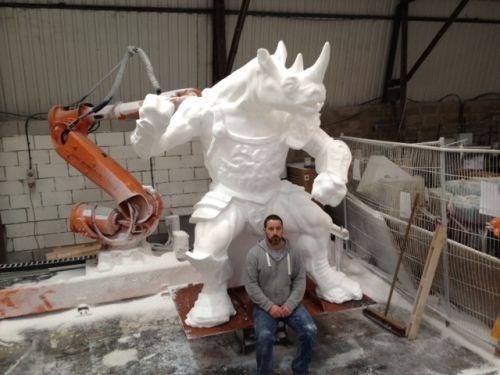Machining with Robots
Several exhibitors at the recent EMO show in Hannover, Germany, featured demonstrations of robotic arms wielding live cutting tools such as end mills or face mills. Perhaps the most dramatic demo was presented by Delcam to showcase this CAM developer’s PowerMill Robot Interface.
Share





Several exhibitors at the recent EMO show in Hannover, Germany, featured demonstrations of robotic arms wielding live cutting tools such as end mills or face mills. Perhaps the most dramatic demo was presented by to showcase this CAM developer’s PowerMill Robot Interface. The interface is designed for programming robots to do multi-axis machining operations. The demo consisted of two FANUC robots working together to carve the rhinoceros-like head of a greatly enlarged fantasy action figure. On robot manipulated the pallet-mounted workpiece, while the other robot maneuvered the powered end mill.

Simulation of robotic motion enables the programmer to optimize machining operations.
This new robot interface is an application embedded inside the company’s PowerMill CAM system as a plug-in. This approach makes it as easy to program a robot for machining as it is to program a five-axis machine tool, the company says, as demonstrated in .
The core functionality of the interface consists of three main steps: programming, simulation (including analysis) and creation of the robot programs. Robots can be programmed for tool-to-part applications, such as machining large parts or trimming composite panels. Robots can also be programmed for part-to-tool applications, such as grinding or finishing. The interface can then be used to simulate the complete machining operation and to control the robot’s movements through different variables, such as axis limits, axis priorities and workplane constraints. The simplified workflow makes it easy to program, simulate, review and refine tool paths, while enabling the robots to achieve levels of accuracy similar to many CNC milling machines when cutting softer materials.
Once the results of the simulation have been reviewed, and modified if necessary, the program can be output in the appropriate robot native language, including KUKA, ABB, FANUC, Yaskawa Motoman or Stäubli equipment. This eliminates the need for third-party translation software.

The rhino head machined at EMO is a copy of the one that tops this completed piece produced by , a model studio in the UK.
Related Content
-
Lean Approach to Automated Machine Tending Delivers Quicker Paths to Success
Almost any shop can automate at least some of its production, even in low-volume, high-mix applications. The key to getting started is finding the simplest solutions that fit your requirements. It helps to work with an automation partner that understands your needs.
-
5 Stages of a Closed-Loop CNC Machining Cell
Controlling variability in a closed-loop manufacturing process requires inspection data collected before, during and immediately after machining — and a means to act on that data in real time. Here’s one system that accomplishes this.
-
Using Jaws as Grippers Enables Flexible, Low-Cost Automation
VersaBuilt’s automation systems significantly boosted Innovative Fabrication’s revenue. In return, the shop has helped VersaBuilt optimize its products.
















